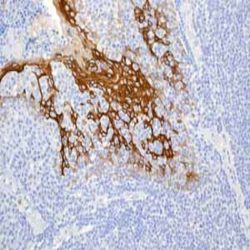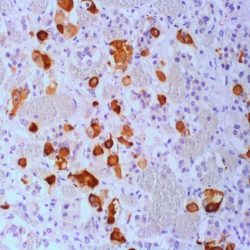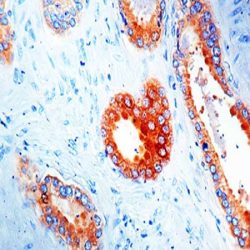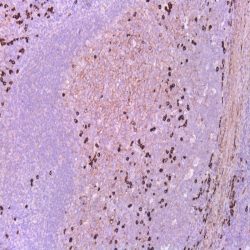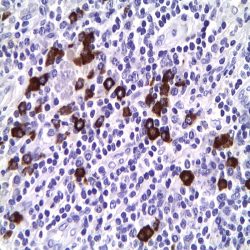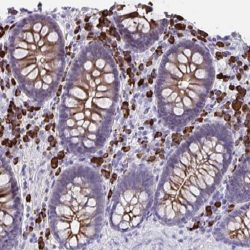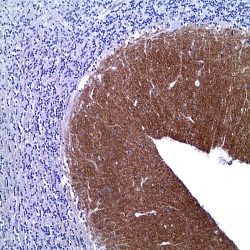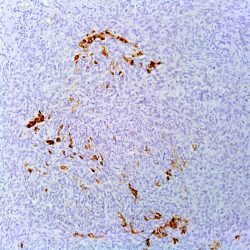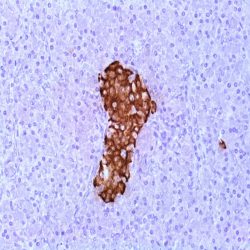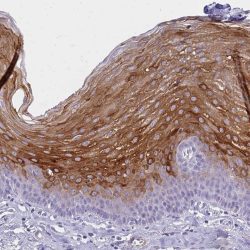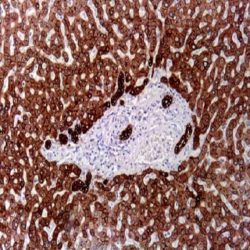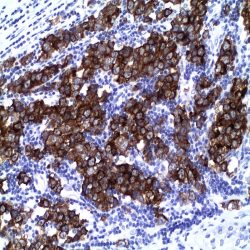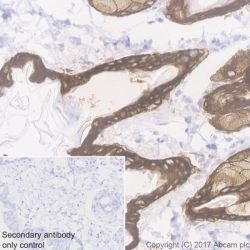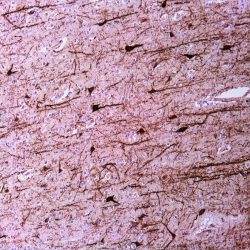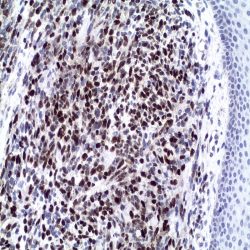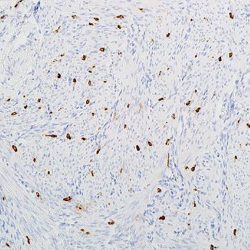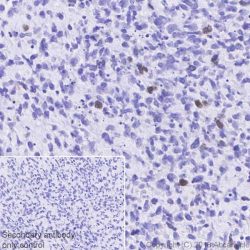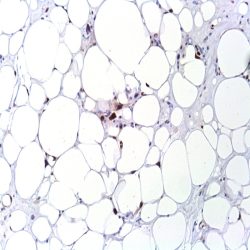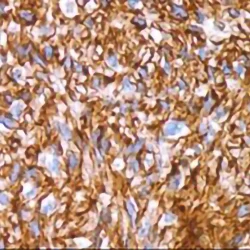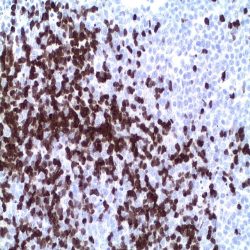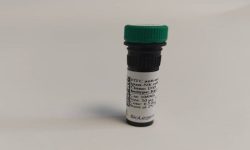Category: monoclonal
Showing 141–160 of 478 results
فیلتر ها-
آنتی بادیهای ایمونوهیستوشیمی
آنتی بادی Cytokeratin 13 (EP69)
Rated 0 out of 5Name: Keratin 13 Monoclonal Antibody Clone EP69
Description and aplications: The nomenclature coined in 1982 by Moll and Franke assigned ranges from 1 to 8 for cytokeratin type II (neutral or basic) and between 9 and 21 for type I (acidic). However and because of the high homology among the different molecules is common for a single monoclonal antibody to react with different types of keratins , for example keratin brand AE1 keratins 10, 14 , 15, 16 and 19. The 54 kD keratin 13 is the major acidic keratin that is assembled in vivo with type 4 and is expressed in the suprabasal cells of the multilayered keratinizing epithelium of mucous membranes, transitional epithelium, pseudostratified epithelium and myoepithelial cells. The monoclonal anti- keratin 13 antibody has been used as a marker for non-keratinized squamous epithelium and is expressed in various squamous metaplasias, but is down regulated in squamous dysplasia and squamous carcinoma. It is useful to identify epithelial derived tumors of the trachea, apocrine and eccrine sweat glands, salivary glands, stem cells of the endocervical glands, bladder, exocervix , tongue, esophagus, anus and basal layer of the epidermis.In addition, mutations in the gene sequence of keratin 13 have been implicated in genetic disease known as autosomal dominant white sponge nevus of the oral cavity.
Composition: anti-Keratin 13 rabbit monoclonal antibody obtained from supernatant culture and prediluted in a tris buffered solution pH 7.4 containing 0.375mM sodium azide solution as bacteriostatic and bactericidal. The amount of the active antibody was not determined.
Immunogen: Synthetic peptide corresponding to human keratin 13 residues.
-
آنتی بادیهای ایمونوهیستوشیمی
آنتی بادی Prolactin (EP193)
Rated 0 out of 5Name: Prolactin Antibody clone EP193
Description and applications: Prolactin is a peptide hormone secreted by the anterior pituitary that is necessary for the proliferation and differentiation of the mammary glands. Prolactin also acts in a cytokine-like manner and as an important regulator of the immune system. Prolactin has important cell cycle related functions as a growth, differentiating and antiapoptotic factor. Prolactin is secreted by lactotrophs in the anterior pituitary. Prolactin producing cells make up approximately 20 percent of the pituitary. Elevated counts of these cells have been observed in pregnant women, newborns and in multiparous women. An antibody to prolactin is useful for the identification of pituitary tumors.
Composition: Anti-human Prolactin rabbit monoclonal antibody purified from serum and prepared in 10mM PBS, pH 7.4, with 0.2% BSA and 0.09% sodium azide
Immunogen: A synthetic peptide corresponding to residues of human Prolactin protein
-
آنتی بادیهای ایمونوهیستوشیمی
آنتی بادی Prostate-specific antigen (PSA) (ER-PR8)
Rated 0 out of 5Name: PSA antibody Clone ER-PR8
Description and applications: PSA is an antigen present in prostatic tissue and in the majority of prostatic carcinomas. This antibody recognizes primary and metastatic prostatic neoplasms and rarely in tumors of nonprostatic origin. These include breast and a minority of salivary gland tumors. The antigen is a 33-34 kD glycoprotein that is restricted to epithelial cells of the prostate. Because of the high specificity of PSA for prostate glandular epithelium, the antibody is useful to identify prostatic carcinomas of the prostate and their frequent infiltration of the surrounding organs (eg .: rectum and urinary bladder). Rectal adenocarcinomas, urothelial carcinoma or adenocarcinoma of the urinary bladder did not express PSA. The loss of immunoreactivity for PSA which can occur in poorly differentiated neoplasms cannot completely exclude the diagnosis of prostate cancer with a negative PSA. Another important use is for differential diagnosis and determine the origin of the primary tumor with metastases of unknown origin, especially lymph node and bone. PSA can be used together with the Prostein, which has at least the same sensitivity and is slightly more specific tha PSA.
Composition: anti-human PSA mouse monoclonal antibody purified from supernatant diluted in tris bffered saline, pH 7.3-7.7, with protein base, and preserved with sodium azide.
-
آنتی بادیهای ایمونوهیستوشیمی
آنتی بادی Prostatic Acid Phosphatase (PASE/4LJ)
Rated 0 out of 5Name: Prostatic Acid Phosphatase Antibody Clone PASE/4LJ
Description and Applications: Anti-PSAP reacts with prostatic acid phosphatase in the glandular epithelium of normal and hyperplastic prostate, carcinoma of the prostate and metastatic cells of prostatic carcinoma. This marker may be helpful in pinpointing the site of origin in cases of metastatic carcinoma of the prostate, and is considered a more sensitive marker than PSA. However, it also offers less specificity. Nevertheless, PSAP complements PSA in the right clinical context.
Composition: Anti-human Prostatic Acid Phosphatase mouse monoclonal antibody purified from serum and prepared in 10mM PBS, pH 7.4, with 0.2% BSA and 0.09% sodium azide
-
آنتی بادیهای ایمونوهیستوشیمی
آنتی بادی Human IgG (E20-V)
Rated 0 out of 5Name: IgG Antibody Clone E20-V
Description and applications: The antibody labels the IgGs contained in the plasma cells and their precursors. In general, membrane bound immunoglobulins, extracellular immunoglobulins bound to connective tissue or blood vessels, and immunocomplexes can only be demonstrated in frozen tissues. Plasma cells may not
be intensely stained in frozen tissue since the immunoglobulins are distributed diffusely through the cytoplasm of these cells. This antibody is useful for identifying leukemias, plasmacytomas and B cells derived from Hodgkin lymphomas. Due to the restrictions on the expression of light and heavy chains in these diseases, demonstration of B-cell lymphomas is possible with clonal rearangements studies. Another application isComposition: Anti-human IgG rabbit monoclonal antibody purified from serum and prepared in 10mM PBS, pH 7.4, with 0.2% BSA and 0.09% sodium azide.
-
آنتی بادیهای ایمونوهیستوشیمی
آنتی بادی IgG4 (EP138)
Rated 0 out of 5Name: IgG4 Antibody Clone EP138
Description and applications: Human IgG4, one of four subclasses of IgG, contains a gamma 4 heavy chain and a hinge region that is shorter than that of IgG1. No allotypes have been detected on the heavy chains of IgG4. Its two primary effector functions are activating complements and binding to the FcgR of effector cells to initiate phagocytosis. Human IgG4 accounts for less than 6% of the total IgG serum level. Recent studies show that serum levels and immunohistochemistry staining with IgG4 antibody is a useful diagnosis marker for IgG4-related sclerosing diseases. A new concept of IgG4-related systemic disease (ISD) has been established recently. The ISD is characterized by elevated serum IgG4 levels and extensive IgG4+ plasma cell infiltrate in pancreas and/or in other organs, including peripancreatic tissue, bile duct, gallbladder, portal area of the liver, gastric mucosa, colonic mucosa, salivary glands, lymph nodes, and bone marrow. Immunohistochemistry analysis of IgG4 is useful for identifying ISD.
Composition: anti-human IgG4 rabbit monoclonal antibody purified from serum and prepared in 10mM PBS, pH 7.4, with 0.2% BSA and 0.09% sodium azide.
-
آنتی بادیهای ایمونوهیستوشیمی
آنتی بادی Immunoglobulin J chain (SP105)
Rated 0 out of 5Name: J Chain Immunoglobulin Antibody Clone SP105
Description and applications: J chain is a small glycopeptide and is structurally unrelated to heavy or light chains, but is synthesized by all plasma cells that secrete polymeric immunoglobulins. J chain is linked to IgA and IgM by disulfide bonds, however, it has been detected in IgG- and IgD-containing cells. J chains are present in a large proportion of the immunoglobulin-positive cells in the germinal centers of the tonsil and lymph node. B cells secrete J chain at an early stage of differentiation with the expression persisting in those cells destined to produce IgA or IgM. It has been shown that a significant proportion of mesangial immunoglobulin deposits of IgA nephropathy are dimeric and therefore positive for this antibody.
Composition: anti-human J Chain immunoglobulin rabbit monoclonal antibody purified and prepared in 10mM PBS, pH 7.4, with 0.2% BSA and 0.09% sodium azide.
-
آنتی بادیهای ایمونوهیستوشیمی
آنتی بادی IMP 3 (EP286)
Rated 0 out of 5Name: IMP 3 Antibody Clone EP286
Description and applications: IMP-3, known as Insulin-like growth factor 2 (IGF-II) mRNA-binding protein 3, is an oncofetal protein that stabilizes IGF-II mRNA for trafficking and plays an important role in cell growth and migration. This 65- 70 kDa protein is expressed normally in developing tissues during early embryogenesis in a variety of fetal tissues including the liver, lung kidney, thymus, and placenta, but at low or undetectable levels in normal adult tissues. Recent studies have demonstrated IMP-3 expression in various malignant tumors of the lung, gastrointestinal tract, liver, endometrium, and bladder, while undetectable in adjacent benign tissues. IMP-3 may have a critical role in tumor proliferation, invasion and metastasis, and has been suggested to be an independent marker for poor prognosis in patients with clear cell carcinomas.
Composition: Anti-human IMP 3 rabbit monoclonal antibody purified from serum and prepared in 10mM PBS, pH 7.4, with 0.2% BSA and 0.09% sodium azide.
-
آنتی بادیهای ایمونوهیستوشیمی
آنتی بادی Inhibin Alpha (R1)
Rated 0 out of 5Name: Inhibin Alpha Antibody (Clone R1)
Description and applications: This antibody recognizes the 32kDa alpha subunit of human inhibin. Inhibin alpha is expressed in a range of tissues including prostate, brain, adrenal gland, testis and ovary. The antibody may be of value in the differentiation of adrenocortical tumors, placental and gestational trophoblastic lesions and sex cord stromal tumors.
Composition: anti-human Inhibin alpha mouse monoclonal antibody purified from ascites. Prepared in 10mM PBS, pH 7.4, with 0.2% BSA and 0.09% sodium azide.
-
آنتی بادیهای ایمونوهیستوشیمی
آنتی بادی Insulin (EP125)
Rated 0 out of 5Name: Insulin Antibody Clone EP125
Description and applications: Insulin is a hormone that regulates glucose homeostasis. It increases cell permeability to monosaccharides, amino acids and fatty acids, and it accelerates glycolysis, the pentose phosphate cycle, and glycogen synthesis in liver. It is synthesized in the beta cell of the pancreas. The antibody labels both normal and neoplastic insulinproducing cells. It is useful in identifying insulinoma.
Composition: Anti-human Insulin rabbit monoclonal antibody purified from serum and prepared in 10mM PBS, pH 7.4, with 0.2% BSA and 0.09% sodium azide.
-
آنتی بادیهای ایمونوهیستوشیمی
آنتی بادی Involucrin (SY5)
Rated 0 out of 5Name: Involucrin Antibody Clone SY5
Description and applications: Involucrin is expressed in a range of stratified squamous epithelia, including the cornea. In normal epidermis, it is first expressed in the upper spinous layers, and in keratinocyte cultures it is expressed by all cells that have left the basal layer. Involucrin expression is abnormal in squamous cell carcinomas and premalignant lesions, and is reduced in severe dysplasias of the larynx and cervix.
Composition: Anti-human Involucrin mouse monoclonal antibody purified from serum and prepared in 10mM PBS, pH 7.4, with 0.2% BSA and 0.09% sodium azide.
-
آنتی بادیهای ایمونوهیستوشیمی
آنتی بادی KI 67 (SP6)
Rated 0 out of 5Name: Rabbit Anti-Human Ki-67 Monoclonal Antibody clone SP6
Description and aplications: This rabbit monoclonal antibody (clone SP6) reacts with a nuclear antigen which is expressed in every proliferating human cell. It is expressed mainly during the cell cycle phases, including late G1, S, G2 and M phase. The cells in the G0 phase (quiescent cells) are not immunostained. This antibody is useful to identify the degree of cell proliferation. Is a marker to define the growth fraction in benign and malignant tissues, such as prostate, breast or lymphoid tissues. Therefore, it can play an important role as a predictor of malignancy.
Composition: anti-Ki67 rabbit monoclonal antibody obtained from supernatant culture and prediluted in a tris buffered solution pH 7.4 containing 0.375mM sodium azide solution as bacteriostatic and bactericidal.
Intended use : Immunohistochemistry (IHC) on paraffin embedded tissues. Not tested on frozen tissues or Western-Blotting
Immunogen: Synthetic peptide derived from the Cterminus of human Ki67 protein
Species reactivity: In vitro diagnostics in humans. Not tested in other species
-
آنتی بادیهای ایمونوهیستوشیمی
آنتی بادی Cytokeratin 18 (DC-10)
Rated 0 out of 5Name: Keratin 18 Antibody Clone DC-10
Description and applications: The nomenclature coined in 1982 by Moll and Franke assigned ranges from 1 to 8 for keratin type II (neutral or basic) and between 9 and 21 for type I (acidic). However and because of the high homology among the different molecules is common for a single monoclonal antibody to react with different types of keratins , for example keratin brand AE1 keratins 10, 14 , 15, 16 and 19. This antibody reacts with the acid intermediate filament protein of 45 kDa keratin, identified as Keratin 18. Keratin 18 is generally co-expressed with the keratin 8 in most simple gland epithelia. In general, the keratin 18 does not react with squamous multilayered epithelium. In neoplastic tissues, this antibody reacts with different benign and malignant epithelial lesions. Most adenocarcinomas and basal cell carcinomas express this keratin, whereas it is absent in squamous cell carcinomas.
Composition: anti-Keratin 18 mouse monoclonal antibody obtained from supernatant culture and prediluted in a tris buffered solution pH 7.4 containing 0.375mM sodium azide solution as bacteriostatic and bactericidal. The amount of the active antibody in the sample is 3,3 μg/mL..
Immunogen: Human breast cancer PMC 42 cells.
-
آنتی بادیهای ایمونوهیستوشیمی
آنتی بادی LIN-28 (EP150)
Rated 0 out of 5Name: LIN-28 Antibody Clone EP150
Description and applications: LIN28 is a highly conserved, RNA-binding protein (RBP). It plays an important role as a translational enhancer, leading specific mRNAs to polysomes and therefore increasing the competence of protein synthesis. LIN28 was identified as a negative regulator of miRNA biogenesis and suggested to play a central role in blocking miRNAmediated differentiation in stem cells and certain cancers. LIN28 is expressed by various undifferentiated embryonic cell types. Anti- LIN28 has been used as a sensitive marker for germ cell tumors. The positive staining of LIN28 in yolk sac tumors showed an advantage over OCT4, which is negative in these tumors.
Composition: Anti-human LIN-28 rabbit monoclonal antibody purified from serum and prepared in 10mM PBS, pH 7.4, with 0.2% BSA and 0.09% sodium azide.
-
آنتی بادیهای ایمونوهیستوشیمی
آنتی بادی Cytokeratin 5 (SP27)
Rated 0 out of 5Name: Cytokeratin 5 Antibody Clone SP27
Description and applications:Twenty human keratins are divided into acidic (pI <5.7) and basic (pI >6.0) subfamilies. Members of the acidic and basic subfamilies are found together in pairs. The composition of keratin pairs varies with the epithelial cell type, stage of differentiation, cellular growth environment, and disease state. Many studies have shown the usefulness of keratins as markers in
cancer research and tumor identification. Point mutations in keratin 5 gene can cause various types of epidermolysis bullosa simplex. Keratin 5 is expressed in most epithelial cells, prostate basal cells and epithelial and biphasic mesotheliomas.Composition: Anti-human Cytokeratin 5 rabbit monoclonal antibody purified from serum and prepared in 10mM PBS, pH 7.4, with 0.2% BSA and 0.09% sodium azide.
Immunogen: Synthetic peptide from Cterminus of human cytokeratin 5.
-
آنتی بادیهای ایمونوهیستوشیمی
آنتی بادی MAP-2 (AP20)
Rated 0 out of 5Name: Mouse anti-human MAP-2 Monoclonal Antibody clone AP20
Description and applications: MAP-2 (microtubule associated protein-2) is one of several high molecular weight proteins that play an important role in brain neuron microtubule assembly. In addition to its association with microtubules, MAP- 2 associates with neurofilaments and actin filaments suggesting that it may guide interaction among microtubules, other cytoskeletal elements, and cytoplasmic organelles. MAP-2 is a stringent marker for neurons. In addition, MAP-2 displays intracellular specificity. In the central nervous system, MAP-2 is confined to neuronal cell bodies and dendrites. There are exceptions, however, where some axons stain positive for small amounts of MAP-2. MAP-2 is uniformly distributed throughout the cell when first expressed in cultured neurons but becomes selectively localized as dendritic development proceeds.
Composition: Anti-human MAP-2 mouse monoclonal antibody purified from serum and prepared in 10mM PBS, pH 7.4, with 0.2% BSA and 0.09% sodium azide
Intended use: Immunohistochemistry (IHC) on paraffin embedded tissues. Not tested on frozen tissues or Western-Blotting
-
آنتی بادیهای ایمونوهیستوشیمی
آنتی بادی MyoD1 (EP212)
Rated 0 out of 5Name: Rabbit anti-human Myo-D1 Monoclonal Antibody clone EP212
Description and applications: MyoD1 is a protein with a key role in regulating muscle differentiation. It regulates muscle cell differentiation by inducing cell cycle arrest, a prerequisite for myogenic initiation. The protein is also involved in muscle regeneration. MyoD1 is expressed in developing skeletal muscle tissue but faintly in adult skeletal muscle. In abnormal tissues, it labels tumour cell in rhabdomyosarcoma. MyoD1 is one of the earliest markers of myogenic commitment. Antibody to MyoD1 has been useful to differentiate rhabdomyosarcomas from other tumors. It is a sensitive and specific marker for myogenic differentiation
Composition: anti-human Myo-D1 rabbit monoclonal antibody purified from ascites. Prepared in 10mM PBS, pH 7.4, with 0.2% BSA and 0.09% sodium azide
Intended use: Immunohistochemistry (IHC) on paraffin embedded tissues. Not tested on frozen tissues or Western-Blotting
-
آنتی بادیهای ایمونوهیستوشیمی
آنتی بادی Mast Cell Tryptase (EP259)
Rated 0 out of 5Name: Mast Cell Tryptase Antibody Clone EP259
Description and applications: Human mast cell tryptase, comprises a family of trypsin-like neutral serine proteinases that are predominantly expressed in mast cells. Tryptase has effects on peptides, proteins, cells, and tissues, and many of these actions can ultimately contribute to asthma symptoms. Mast-cell tryptase is found in mast-cell granules and has also been reported to be expressed by peripheral blood basophils at low level. Tryptase has been used as a marker of mast cell activation.
Composition: Anti-human Mast Cell Tryptase rabbit monoclonal antibody purified from serum and prepared in 10mM
PBS, pH 7.4, with 0.2% BSA and 0.09% sodium azide. -
آنتی بادیهای ایمونوهیستوشیمی
آنتی بادی Myogenin (EP162)
Rated 0 out of 5Name: Myogenin-Clone EP162
Description and applications: acid-rich region and a helix-loop-helix (HLH) structure, which can promote muscle development and maintain muscle-specific gene expression by transactivation. Myogenin, one of the myogenic regulatory factors, plays a key role in determining the commitment and differentiation of primitive mesenchymal cells into skeletal muscle. The expression of Myogenin is restricted to cells of skeletal muscle origin, but it is not detected in adult skeletal muscles. It is therefore considered to be an extremely reliable and specific marker for diagnosing rhabdomyosarcomas. Myogenin is positive in virtually 100% of alveolar, sclerosing and botryoides rhabdomyosarcoma and in over 60% of pleomorphic rhabdomyosarcoma and is useful in recognizing adult spindle cell rhabdomyosarcomas. Less than 20% of Wilms tumors, congenital infantile fibrosarcoma, childhood myofibromatosis, synovial sarcoma and desmoid tumors have been reported positive. Ewing sarcoma, rhabdoid tumor, epithelioid sarcoma, leiomyosarcoma, miofibrosarcomas and nodular fasciitis show no reactivity to myogenin.
Composition:anti-human Myogenin rabbit monoclonal antibody purified by protein affinity and prepared in 10mM PBS, pH 7.4, with 0.2% BSA and 0.09% sodium azide.
Immunogen: A synthetic peptide corresponding to residues in human Myogenin was used as an immunogen.
-
آنتی بادیهای ایمونوهیستوشیمی
آنتی بادی MDM2 (IF2)
Rated 0 out of 5Name: Mouse anti-human MDM2 Monoclonal Antibody clone IF2
Description and aplications: MDM2 (murine double minute 2) or E3 ubiquitinprotein ligase, is a protein encoded by the chromosomal region 12q13-15, and mediates the ubiquitination of p53 / TP53 leading to its degradation by the proteasome. Due to MDM2 binding to the transcriptional activation domain of p53 / p73 TP53- and p73/ TP73- inhibits G1 arrest of the cell cycle and apoptosis. It also acts as an E3 ubiquitin ligase and ARRB1 itself. Allows nuclear export of p53 / TP53. It promotes ubiquitin-dependent proteasomeindependent degradation of the retinoblastoma protein (RB1). This monoclonal antibody reacts specifically with human MDM2 protein. Immunohistochemical detection of MDM2 and CDK4 overexpression may be helpful to distinguish between well-differentiated liposarcomas and benign tumors of adipocytes (sensitivity / specificity 100% / 58.8% and 68.4% / 88.2%, respectively) and between dedifferentiated liposarcoma from other malignant mesenchymal tumors. MDM2 and CDK4 are expressed in 100% and 93% of dedifferentiated liposarcoma and in only 18% of malignant tumors of peripheral nerve sheaths, mixofibrosarcomas, embryonal rhabdomyosarcoma and 1-6% of poorly differentiated sarcomas (malignant fibrous histiocytoma and leiomyosarcoma). Overexpression of MDM2 / CDK4 proteins is also a highly sensitive marker for the diagnosis of low grade osteosarcomas.
Composition: anti-human MDM2 mouse monoclonal antibody purified from ascites fluid by Protein A chromatography. Prepared in 10mM PBS, pH 7.4, with 0.2% BSA and 0.09% sodium azide
Intended use : Immunohistochemistry (IHC) on paraffin embedded tissues. Not tested on frozen tissues or Western-Blotting
Immunogen: Synthetic peptide derived from the Nterminal region of human MDM2

